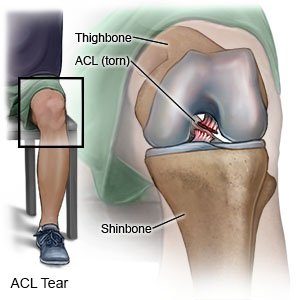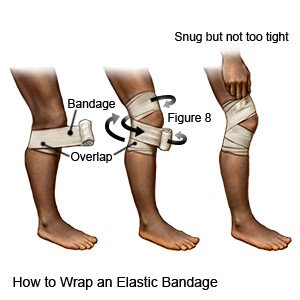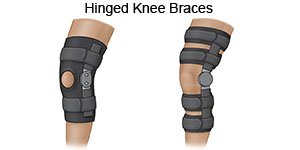ACL Injury in Children
Medically reviewed by Drugs.com. Last updated on Apr 6, 2025.
What is an anterior cruciate ligament (ACL) injury?
An ACL injury is a partial or complete tear of the ACL. The ACL is a ligament in your child's knee that connects the tibia (shin bone) to the femur (thigh bone). Ligaments are strong tissues that connect bones. The ACL stops the tibia from sliding too far forward and keeps the knee stable.
 |
What are the signs and symptoms of an ACL injury?
- A pop, snap, or tear when the ACL is injured
- Sudden swelling or pain in the knee
- The knee cannot support your child's weight
- A change in the way your child walks, such as with stiff legs
- Trouble putting weight on the leg or straightening the knee
How is an ACL injury diagnosed?
Healthcare providers may test the function of your child's ACL. They may move the knee, leg, or foot in different directions. Your child may be asked to lean or hop using the leg with the injured knee. Your child will be asked to tell the provider if he or she feels pain during these or other activities. Both of your child's knees may be checked for any abnormal movement. Your child may need the following tests:
- An x-ray or MRI may be used to look for an ACL tear. Your child may be given contrast liquid to help the knee show up better in pictures. Tell a healthcare provider if your child has ever had an allergic reaction to contrast liquid. Do not let your child enter the MRI room with anything metal. Metal can cause serious injury. Tell the healthcare provider if your child has any metal in or on his or her body.
- Arthroscopy is a procedure used to look inside your child's knee for an ACL injury. A small incision is made in the knee and a scope is inserted. The scope is a long, bendable tube with a camera and light on the end.
How is an ACL injury treated?
- NSAIDs , such as ibuprofen, help decrease swelling, pain, and fever. This medicine is available with or without a doctor's order. NSAIDs can cause stomach bleeding or kidney problems in certain people. If your child takes blood thinner medicine, always ask if NSAIDs are safe for him or her. Always read the medicine label and follow directions. Do not give these medicines to children younger than 6 months without direction from a healthcare provider.
- Acetaminophen decreases pain and fever. It is available without a doctor's order. Ask how much to give your child and how often to give it. Follow directions. Read the labels of all other medicines your child uses to see if they also contain acetaminophen, or ask your child's doctor or pharmacist. Acetaminophen can cause liver damage if not taken correctly.
- Prescription pain medicine may be given if other pain medicines do not work. Do not wait until the pain is severe before you give your child this medicine. Ask your child's healthcare provider how to give this medicine safely.
- Surgery may be needed if your child has an ACL tear or damage to other knee ligaments.
How can I manage my child's ACL injury?
- Have your child rest his or her leg as directed. Ask your child's healthcare provider when he or she can return to normal activities. Your child may not be able to play certain sports until the injury heals. Work with your child's healthcare providers and school officials to plan a safe return to competitive sports.
- Apply ice to decrease swelling and pain. Use an ice pack, or put crushed ice in a plastic bag. Cover the bag with a towel before you place it on your child's injured ligament. Apply ice for 15 to 20 minutes every hour, or as directed.
- Apply compression to support the ligament and help decrease swelling. Your child's healthcare provider can tell you how often to do this.

- Elevate the area above the level of your child's heart as often as you can. This will help decrease or limit swelling. Rest your child's lower leg and foot on pillows. Do not put the pillow directly under his or her knee.

- Have your child use support devices as directed. A knee brace may be used to limit movement and protect your child's knee. Your child may need to use crutches to help decrease pain as he or she moves around.

- Take your child to physical therapy, if directed. A physical therapist can teach your child exercises to help improve movement and strength, and to decrease pain. The exercises can also help increase the range of motion in your child's knee.
When should I seek immediate care?
- Your child's toes are cold or numb.
- Your child's knee becomes more weak or unstable.
- Your child's pain has increased or returned, even after he or she takes pain medicine.
- Your child's swelling has increased or returned.
- Your child's symptoms are not getting better.
When should I call my child's doctor?
- Your child has a fever.
- You have questions or concerns about your child's condition or care.
Care Agreement
You have the right to help plan your child's care. Learn about your child's health condition and how it may be treated. Discuss treatment options with your child's healthcare providers to decide what care you want for your child. The above information is an educational aid only. It is not intended as medical advice for individual conditions or treatments. Talk to your doctor, nurse or pharmacist before following any medical regimen to see if it is safe and effective for you.© Copyright Merative 2025 Information is for End User's use only and may not be sold, redistributed or otherwise used for commercial purposes.
Further information
Always consult your healthcare provider to ensure the information displayed on this page applies to your personal circumstances.
